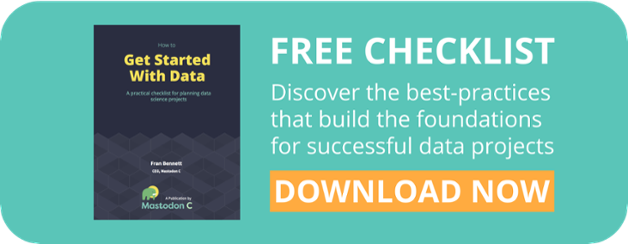You may have an idea that data science can bring value to your organization, but do your senior leaders share your excitement? Possibly not. Well not yet anyway. The key is making a persuasive case that gets you the support and resources you need. But building support for a data science initiative requires taking a different approach to the classic business case process many organisations use. And that can make things tricky.
What’s Different About Data Science?
In common with many technology projects, businesses get better value from data science when they use approaches like Agile that allow them to quickly release products and adapt as they go. This is certainly the case for data science projects which are often exploratory in nature, and particularly if you’re trying a data-driven approach for the first time. The problem is that leaders who want to use money or resources to do something new are often forced into a way of thinking that is pretty much the opposite of Agile.
The classic business case development process requires a detailed examination of the problem, research into the current context, consideration of different options, return on investment calculations, risk and mitigation plans, resource allocations and so on. This level of analysis is intended to bring discipline to decision making. The detail is reassuring. But it’s often the detail that’s the problem.
The devil is in the detail
Things change quickly in the world of work. In a matter of moments the key factors documented during the research phase of a business case can dramatically change. Competitors react, budgets are cut, new legislation emerges, people leave. No business case can hope to offer mitigation for every risk. No business case can plan for everything that can, and will, change. Which is why the agile approach of releasing quickly, adapting fast and learning as you go works so well.
But that doesn’t mean that a promise to be Agile and a winning smile means you can expect unreserved blessings and an open chequebook for your data project. So, here are some tips and techniques for getting buy-in for your plan:
Find a big problem or a big opportunity. The key to making the case for any data science project is to identify real business problems and their pain points - then explain why the data-drive approach you’re advocating is the best way to address them. Explain how the organisation will take important action based on the question you’ll be answering or the insights you’ll generate, and how you’ll report back your results. Be clear about the role data plays in delivering results.
Focus on business benefits. What gets you excited will not necessarily impress the person with the budget or resources you need. It’s likely that their priorities are different to yours and they’ll need to understand both costs and benefits. Getting to grips with cost is easy - you will have proposals from outside experts or a costed project plan for using internal resources. The nitty gritty of finding and presenting the benefits is the tricky but essential bit.
You need to get to the bottom of benefits, otherwise you’re just asking for a cash handout. And that’s not going to get you far. This means that the more you know about the value of solving the problem, the better you’ll be able to define the expected benefits, and the more convincing your proposal becomes. This will mean being clear about the action that could be taken as a result of your project and the impact this action could have. This might also mean speaking to people outside your normal network - planners, compliance officers, marketing and communications specialists.
Psychology suggests you focus on savings. Research by behavioural economists has shown that humans are generally more motivated by fear of loss than potential gains. This suggest that a new initiative stands a better chance of being signed off if it focuses on cost savings, or risk mitigation. For example, uncovering and preventing compliance issues that would otherwise result in fines. Or detecting potential threats to patient safety. That’s not to say that revenue potential should be ignored. But it might be tougher to get buy-in.
Anticipate concerns and objections. Being upfront about potential issues or challenges makes you look thorough. But more importantly it’s a good way of getting people on your side by giving them the chance to help solve the problem. This is where you need your network. You need to understand what’s on the mind of key people in the process. The business may for example have a strategic goal of increasing revenues from a new sector, but if your CIO is currently more concerned about cutting costs then you’ll miss the mark if you focus on revenue generation.
In summary:
DO
Be upfront about potential challenges.
Find a decent business problem to solve.
Identify how the organisation will take action based on your results.
DON’T
Ask for cash without knowing what the benefits will be.
Forget to speak to the people who care most about the problem you’re looking at.
Share this article

